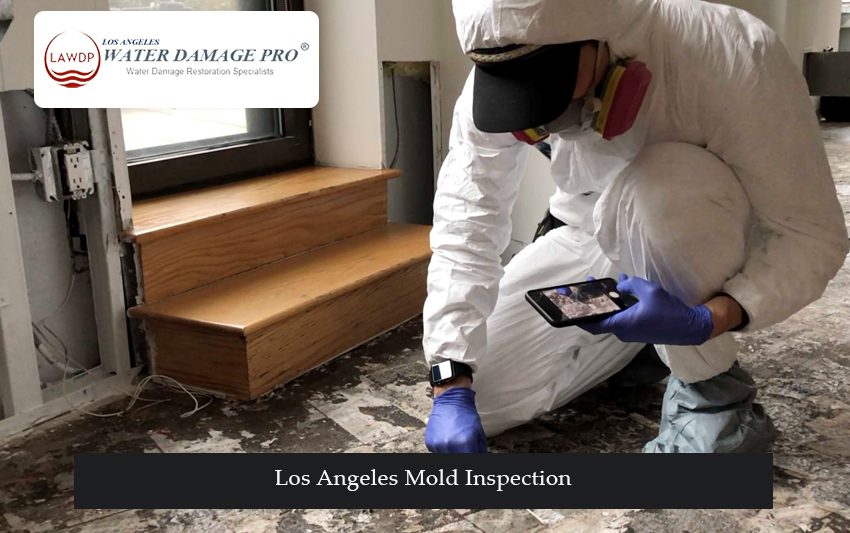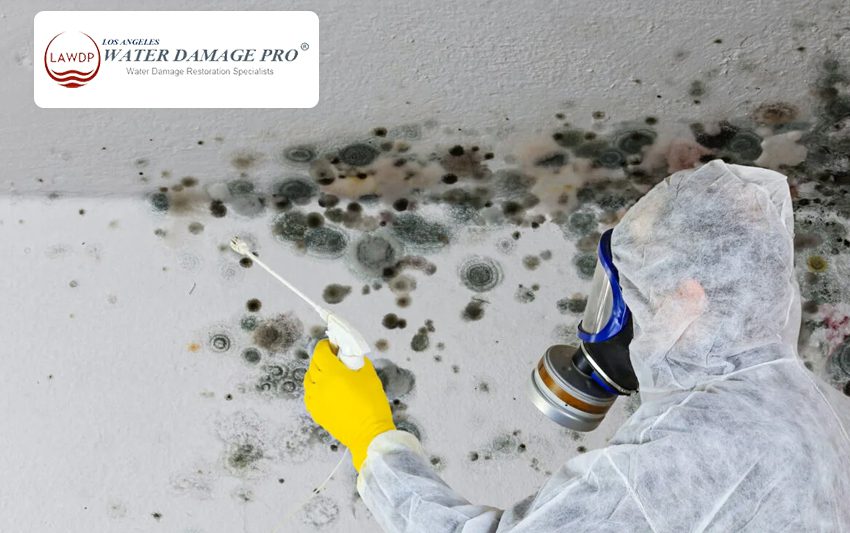Mold Inspection in Los Angeles
A mold inspection helps identify mold growth, the damage’s extent and the underlying moisture source.
At Water Damage Restoration Pro, we understand your need to live in a mold-free space. And that is why we offer a comprehensive service to remove mold from your property to prevent health risks and mitigate future mold growth.
We have the workmanship to inspect your property for mold and damage, saving the hassle of dealing with extensive mold remediation.

When to Consider a Mold Inspection
There are several indicators that can help you identify the need for a mold inspection. This includes the following:
- Visible Mold Growth: Visible mold growth indicates an underlying moisture issue or water damage. Visible mold can appear as patches of discoloration, fuzzy growth, or black spots on walls, ceilings, or other surfaces.
- Water Damage: If you have any past or current water damage, such as leaks, floods, burst pipes, or roof leaks, even if the water damage has been repaired, you need a mold inspection. This is because residual moisture may lead to mold growth in hidden areas like behind walls and under flooring.
- Unexplained Odors: If you notice earthy odors despite your efforts to eliminate them, there might be hidden mold growth. Mold produces volatile organic compounds (VOCs) that can create distinct odors.
- Real Estate Transactions: When buying or selling a property, it is wise to conduct a mold inspection as part of the due diligence process. Mold issues can significantly affect a property’s value and its occupants’ health. It can also help identify any mold problems and the necessary measures to be taken before finalizing the transaction.
The Process of Mold Inspection
Mold inspection involves a thorough assessment of the property to identify the presence of mold, determine the extent of the mold growth, and identify the underlying cause. When you hire Water Damage Restoration Pro for your mold inspection case, we will carry out the following steps:
| Initial Assessment | An inspection of the property, considering visible signs of mold, water damage, or moisture issues, will be done. |
| Moisture and Humidity Assessment | The inspector will use moisture meters and other specialized tools to identify potential areas that let in water. This may include checking for plumbing leaks, roof leaks, condensation issues, or high humidity levels in the property. |
| Air Sampling | Air samples are collected from both indoor and outdoor environments. These samples are usually analyzed in a laboratory to identify the types and quantities of mold spores present. The data collected from this step helps identify the extent of mold contamination and potential health risks. |
| Surface Sampling | If visible molds are present on your property, our inspector will collect the surface samples to help inform the specific mold species and the remediation process needed. |
| Report and Recommendations | The final step will be the provision of a detailed report that highlights the locations and extent of mold growth, moisture sources, recommendations for remediation, moisture control, and preventive measures. |

Preventive Measures and Maintenance after Mold Inspection
Preventive measures and maintenance are important because they help minimize the risk of mold recurrence. They also help maintain a healthy indoor environment. After your mold inspection, consider the following preventative and maintenance measures:
- Address moisture issues
- Improve ventilation in all rooms
- Monitor indoor humidity levels
- Clean and maintain your property regularly to remove dust, dirt, and potential mold spores.
- Monitor and control condensation
- Opt for regular inspections to allow for timely intervention and prevent mold from spreading.
Contact a Mold Inspection Expert
If you are searching for expert services to mitigate mold issues in your home, Water Damage Restoration Pro can help. We will inspect your home for mold, recommend solutions and implement measures to prevent future mold growth.
Don’t let mold grow in your home. Don’t risk your health. Contact us and let us help you identify signs of mold in your home.
FAQs
The frequency of mold inspections depends on various factors, including the age of your property, its location, previous mold issues, and any known moisture problems. The best way to know how often you should schedule an inspection is to ask the inspector and educate yourself on signs of mold growth.
Insurance companies usually cover mold damage if it results from another covered damage. For example, if your insurance covers water damage and your water system leaks and causes mold, you will be covered for mold damage.
Yes, when carrying out mold inspection, mold samples are usually collected and analyzed in a lab to help determine the type of mold and the required solution.
A mold inspection is not the end of the solution. You will need to invite the inspector again to come and implement solutions that will help mitigate mold growth.


